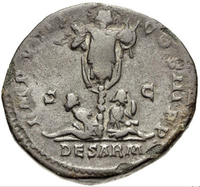This article needs additional citations for verification. (April 2016) |



A tropaion (Greek: τρόπαιον, Latin: tropaeum), from which the English word "trophy" is derived, was a monument erected to commemorate a victory over one's foes by the ancient Greeks and later, by the Romans. The armour of the defeated foe would be hung upon the monument. Originally, the location of the monument was the battlefield where the commemorated victory took place. Initially, the typical monument was constructed out of a living tree with lateral branches, or it was constructed in the shape of one. After construction, the tropaion was dedicated to a deity in thanksgiving for the victory. Some images of tropaion show many weapons and shields heaped below the armor hoisted upon the monument. In later times, pairs of lances, banners, or stakes set crosswise might be used instead of the tree format.